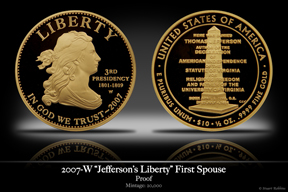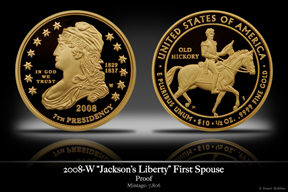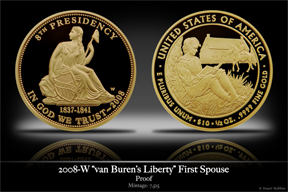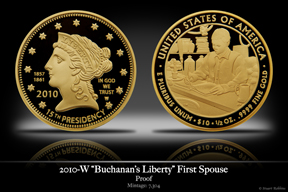First Spouse Series
Overview of the Series
In a section of the law that created the Presidential Dollar series, there was the authorization for the Mint to issue $10 gold coins to honor each president's spouse. Note that the actual face value of $10 is historical -- the 1/2-oz gold coins (prior to 1933) were worth $10. The coins in this series were meant - are meant - to display a portrait of the spouse on the obverse (just like the presidential dollars) and have something on the reverse that portrays a contribution they made. The coins were/are issued in proof and uncirculated strikes, and they were originally limited to 20,000 pieces each, but that number has since gone down as interest in the series waned.
My Collecting Goal
Where my collection comes into play is that some presidents did not have a spouse while in office. The law states that if this is the case, the obvserse should portray the goddess Liberty that was on a coin from the time period that president was in office, and the reverse should portray something emblamatic of that president (not necessarily while they were in office).
Those are the coins that I've opted to collect, in proof condition. The reason I'm not doing the entire series is purely monetary: With around 40 presidents so far, that's 20 oz of gold. At 2007 prices, the series would cost me $18,000 at least, and then of course there's the rising price of gold plus the Mint's general 30% premium. I do NOT have these certified by a third-party grading service, rather I keep them all with their original Mint packaging.
But with just the "So-and-so's" Liberty, that's a total of 4 coins: Thomas Jefferson (3rd), Andrew Jackson (7th), Martin van Buren (8th), and James Buchanan (15th). I buy these directly from the Mint, so I don't pay resale prices. Jefferson's Liberty cost $430 in August '07. Jackson's cost $620 in August '08, and van Buren's cost $550 in November '08.
Starting in 2009, the Mint announced a variable pricing structure for all of their gold and platinum products. For the gold proof First Spouse issues, there is a fixed premium of approximately $165 over the average price of gold the preceeding week. For example, if the average price of one ounce of gold is $1000-$1050, then the premium is $166.50 on the mean of that range to get $679 ($1025/2+$166.50). Based on the average price of gold, Buchanan's Liberty when released from the Mint cost $779.
Thus, the set of 4 proofs from the Mint at original issue prices cost $2378.85 (plus shipping).
The Designs I've Collected
Jefferson's Liberty: The obverse pictures the "Draped Bust" design that originally graced US coins at the turn of the 19th century. It was on the half cent (1800-1808), one cent (1796-1807), half dime (1796-1797, 1800-1805), dime (1796-1807), quarter dollar (1796, 1804-1807), half dollar (1796-1797, 1801-1807), and one dollar (1795-1803). I feel obligated to note, however, that in the latest rendition, the Mint opted to give Liberty breast-reduction surgery, shrinking her bust size considerably.
The reverse features Jefferson's grave marker in Virginia, along with the text that he dictated should be carved on it: "Here was buried Thomas Jefferson author of the Declaration of American Independence of the Statute of Virginia for Religious Freedom and Father of the University of Virginia".
Jackson's Liberty: The obverse features the "Capped Bust" design that was on most silver coins during the second quarter of the 19th century. It was on the half dime (1829-1837), dime (1809-1837), quarter dollar (1815-1838), and half dollar (1807-1839) (a very popular series among collectors).
The reverse features Jackson on a horse with the nickname "Old Hickory" that he received after a battle against 4000 Brittish troops.
van Buren's Liberty: The obverse is the "Seated Liberty" design that replaced the "Capped Bust" on most silver coins and ran throughout the middle of the 19th century. This design actually went through a few modifications (adding stars around the border, then replacing them with "UNITED STATES OF AMERICA"), and the one featured on this coin is the original. I personally don't care for this design on circulated coinage because I think that once you get into coins that are reasonably affordable, the entire center of the design is worn away. However, I really like it on this proof coin. It was on the half dime (1837-1873), dime (1837-1891), twenty cent coin (1875-1878), quarter dollar (1838-1891), half dollar (1839-1891), and silver dollar (1840-1863).
Buchanan's Liberty: The obverse features the classic "Liberty Head" motif that adorned gold coins in the latter half of the 19th century. I have been told that there are actually minor differences in the design among the gold struck during that time period, so this one in particular is from the quarter eagle, designed by Christian Gobrecht and minted from 1840 to 1907.
The reverse is the most interesting to-date, in my opinion. It features van Buren as a boy, reading a book, leaning against a tree outside of the family's tavern.
Buchanan's Liberty: The obverse is the Liberty Head motif that appeared on the quarter eagle ($2.50) gold pieces throughout much of the mid-to-late 1800s. The design appeared on all gold coin obverses ($1 Type 1, $2.50, $5, $10, and $20) save the $3 and the $4 pattern "stellas." However, there are subtle differences on each that does identify this as the quarter eagle (I have been told this, though I do not know what they are).
The reverse shows a young James Buchanan, working as a bookkeper in a small family-owned country store.



